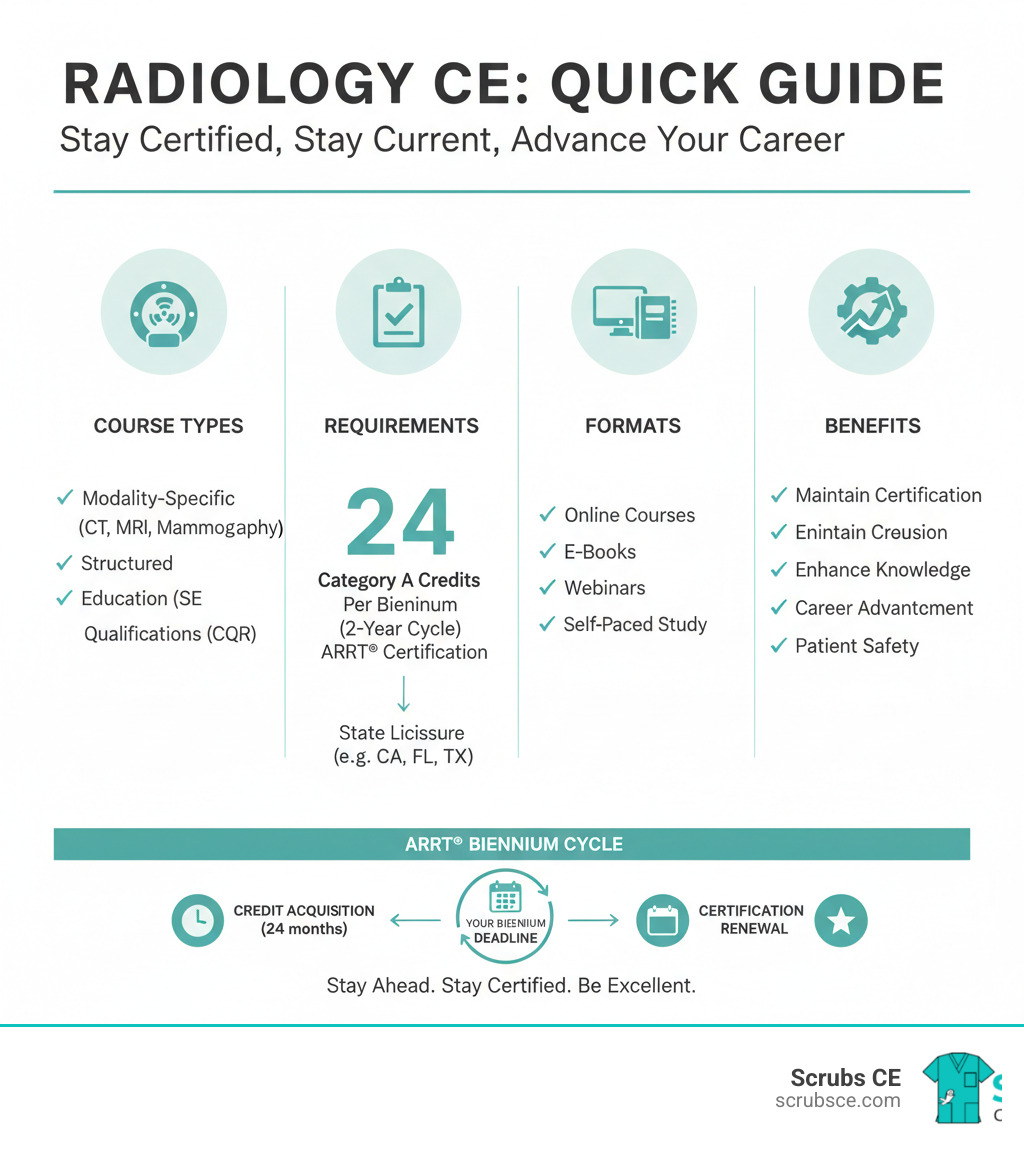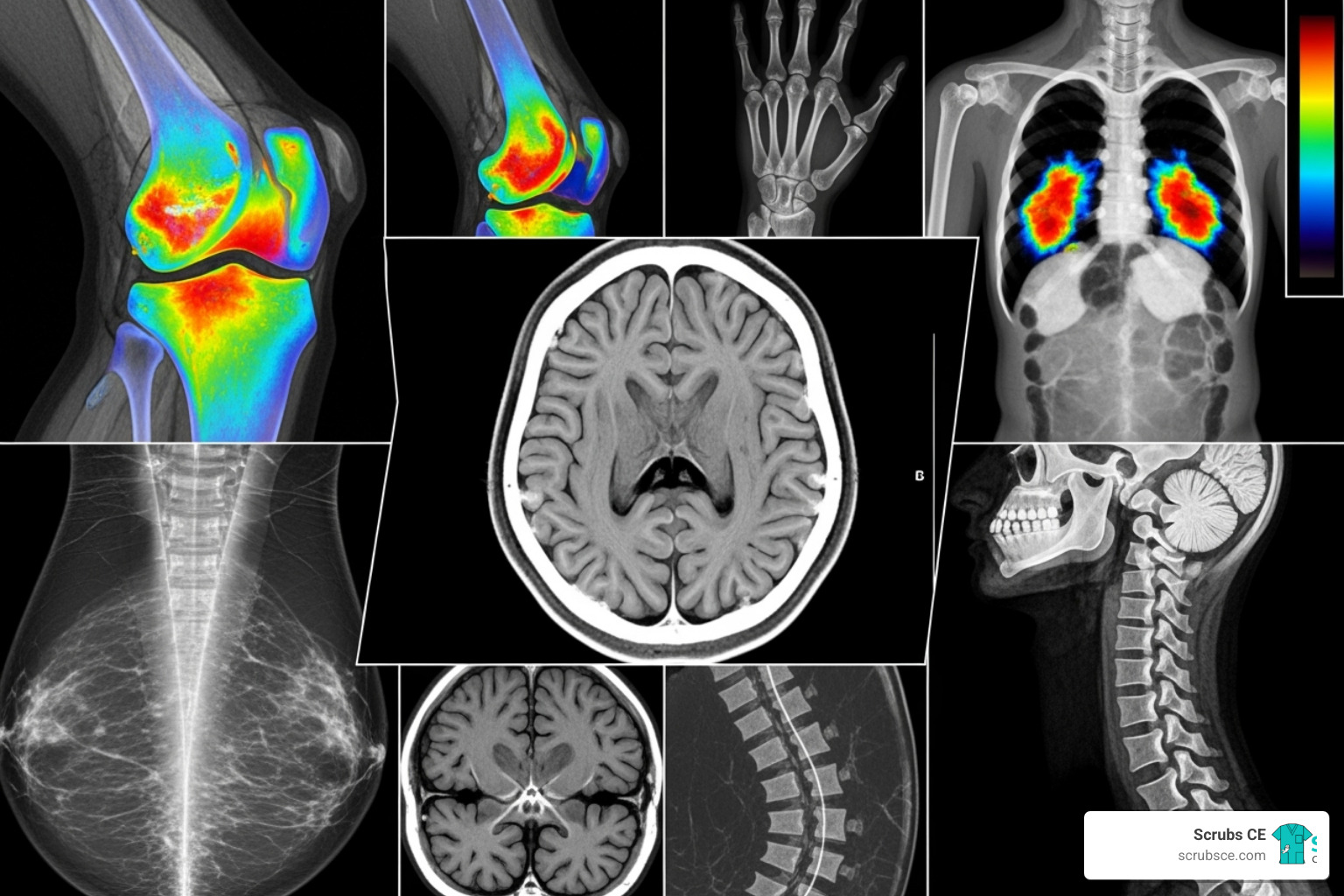Why Radiology Continuing Education Matters for Your Career
Radiology ce courses are accredited programs that help imaging professionals maintain ARRT® certification, meet state licensure requirements, and advance their careers. These courses cover specialized topics across modalities like X-ray, CT, MRI, and mammography.
Quick Guide to Radiology CE Courses:
- Purpose: Maintain ARRT® certification and state licensure while expanding clinical knowledge
- Requirements: Most technologists need 24 Category A credits per biennium (2-year period)
- Course Types: Modality-specific training (CT, MRI, Mammography), Structured Education (SE), Continuing Qualifications Requirements (CQR)
- Formats: Online courses, e-books, webinars, self-paced home study
- Accreditation: Look for ASRT-approved courses accepted by ARRT®, NMTCB, and ARDMS
- Cost: Options range from individual courses ($9.99+) to unlimited annual access plans ($49.99-$54.95)
- State-Specific: Some states like California, Florida, and Texas have additional requirements
The radiology field moves fast with new technologies, evolving protocols, and changing safety standards. Continuing education is more than a checkbox for licensure renewal—it’s your pathway to staying current, expanding your skills, and opening doors to specialized roles.
As one radiologic technologist shared: “I find that this is one of the best resources for obtaining CEU’s. I wish I would have found this site sooner.”
Whether fulfilling basic ARRT® requirements, transitioning to a new modality, or preparing for advanced certification, understanding your CE options helps you make strategic choices for both compliance and career growth.
Why Radiology CE is Essential for Your Career
While continuing education might seem like just another requirement, radiology ce courses are your ticket to staying relevant, growing your career, and delivering the best possible patient care. The radiology field doesn’t stand still; new protocols, equipment, and safety standards emerge constantly. Keeping pace is essential.
Compliance is straightforward: You need CE credits to maintain your ARRT® certification and state license. Most technologists need 24 credits per biennium (a two-year cycle), plus any state-specific requirements. It’s non-negotiable, but it doesn’t have to be a burden. Our article on The Importance of Continuing Education (CE) for X-Ray Technologists details how to stay compliant.
The real value of CE goes beyond credentials. Taking courses that interest you sharpens skills for your daily work, from new techniques and equipment knowledge to updated radiation safety protocols. This directly translates into better patient care: more accurate positioning, clearer images, and safer procedures.
Career advancement is another major benefit. The radiology field offers incredible opportunities to specialize. Strategic CE choices can help you transition into new modalities like MRI or CT, opening doors to different roles, increasing your earning potential, and making you more valuable to employers. If you’re exploring new specialties, check out How to Use Continuing Education to Advance to a Different Modality within Radiology.
Every course is an investment in yourself—you’re building expertise and staying current with technology. For a comprehensive look at the benefits, our guide 7 Ways Radiology CE Can Benefit You as a Radiologic Technologist covers everything from confidence building to networking.
Radiology ce courses are about staying sharp, advancing your career, and providing care that makes a difference. Approached with this mindset, CE becomes an opportunity, not an obligation.
Decoding ARRT ae and State-Specific CE Requirements
Navigating ARRT ae mandates and state rules for continuing education can feel overwhelming, but understanding the basics makes it manageable. The foundation of your CE journey is the ARRT ae biennium, a two-year reporting period during which most certified technologists must complete 24 CE credits. These must be Category A credits, approved by a Recognized Continuing Education Evaluation Mechanism (RCEEM) like the ASRT (American Society of Radiologic Technologists).
For official guidance, visit the ARRT and ASRT websites.
All of our radiology ce courses are ASRT-approved for Category A credit, so you can be confident they count toward your ARRT ae certification. For a detailed breakdown, see our guide on Satisfying Radiology Continuing Education Requirements for the Biennium.
Structured Education (SE) vs. Continuing Qualifications Requirements (CQR)
Beyond the standard 24 credits, you may encounter two other categories: Structured Education (SE) and Continuing Qualifications Requirements (CQR). They serve very different purposes.
Structured Education (SE) is for technologists pursuing post-primary certification in a new specialty, like moving from radiography to CT or MRI. SE courses provide the required academic foundation (e.g., 16 hours for ARRT ae) before you begin clinical experience.
Continuing Qualifications Requirements (CQR) are about maintaining long-term competency. Every ten years, ARRT ae requires a CQR process, which involves a prescribed self-assessment to identify knowledge gaps. You then complete targeted CE to address those specific areas, ensuring your skills stay sharp.
For a comprehensive explanation, read What You Need to Know About ARRT’s Structured Education Solutions and Requirements. You can also find detailed information in the ARRT ae handbook on their official website.
Navigating State-by-State Mandates
While ARRT ae sets the national standard, each state can establish its own state-specific requirements for licensure renewal. It’s essential to stay informed about your state’s rules.
- California, for instance, has specific mandates for fluoroscopy certification. Our radiography courses satisfy California’s requirements; simply use the ASRT number from your completion certificate for state board submission. Learn more in our guide on How to Maintain Your X-Ray License in California.
- Florida often requires courses to be approved by the Florida Department of Health, Bureau of Radiation Control (DOH-BRC). Our courses of 1 credit or more are approved in Florida. Our guide on Florida Radiologic Technology License options offers more insight.
- Texas emphasizes that CE courses must be “directly related” to your scope of practice, highlighting the need for relevant, accredited courses.
Always consult your state’s licensing board for their specific requirements. Our State Agencies page is a helpful starting point for finding this information.
A Guide to the Different Types of Radiology CE Courses
The world of continuing education in radiology is diverse, with courses for every specialty and learning style. Understanding what’s available helps you make smart choices that align with your career goals. If you’re just starting, our guide Radiology and X-Ray Continuing Education Courses: Getting Started can help.
Modality-Specific Radiology CE Courses
Most radiology ce courses focus on specific imaging modalities, allowing you to build expertise or branch into a new area.
- X-Ray (Radiography): Courses cover positioning, physics, and advanced digital techniques. We offer 21 X-Ray courses for $39.99. Explore our Continuing Education Courses for X-Ray Technologists.
- Computed Tomography (CT): Dive into advanced protocols, 3D reconstruction, and image interpretation. We provide 15 CT courses for $35.00.
- Magnetic Resonance Imaging (MRI): Tackle MRI physics, advanced sequences, and specialized applications. Access 22 MRI courses for $39.99. For a full selection, visit CT/MRI CE.
- Mammography: Focus on screening techniques, breast pathology, and quality control. We offer 9 mammography courses for $29.99. See our Mammography CE Courses.
- Nuclear Medicine: Explore radiopharmaceuticals and SPECT/CT and PET/CT imaging. Find courses at Nuclear Medicine CE.
- Ultrasound: Cover diverse applications from abdominal to musculoskeletal imaging. Visit our Ultrasound CE Courses.
- Fluoroscopy: Focus on radiation safety and interventional procedures. See our Fluoroscopy CE Courses.
Beyond modalities, you’ll find courses on broader topics like cross-sectional anatomy, radiation safety, and patient communication. Practical, case-based courses like “A Bone to Pick” (1 CE credit) or “Spinal Imaging Surprises” (2 CE credits) reflect real-world clinical challenges.
Course Formats for Every Learning Style
Radiology ce courses come in various formats to fit your schedule and preferences.
- Online Home Study: The most popular option, offering the flexibility to learn at your own pace, from anywhere.
- E-books and PDFs: Many courses offer downloadable content for offline study. You can read on a tablet or print materials, then take the test online.
- Webinars: These offer an interactive experience with expert presenters and Q&A sessions. They can be live or recorded for convenience.
Most online courses are self-paced, allowing you to start and stop as needed, which is invaluable for balancing work and life. After completing a course, you’ll take a post-test at an Online Testing Center. Once you pass, you receive an instant certificate. Our process makes it easy to Enroll in X-Ray CE Fast and get your documentation without delay.
How to Choose the Right Radiology CE Provider
Finding the right provider for your radiology ce courses is about choosing a reliable, transparent partner for your professional journey. Focusing on a few key areas will help you make a confident choice. For quick questions, our FAQ page can help.
Understanding Accreditations and Approvals
Not all CE credits are equal. Accreditation is what makes your radiology ce courses count, so before investing time and money, ensure credits will be accepted by your certifying body and state licensing board.
The gold standard is ASRT Category A credit, which meets the stringent standards of the ARRT®. Reputable providers will clearly display their ASRT approval. Depending on your specialty, also verify acceptance by other organizations:
- Nuclear Medicine: Nuclear Medicine Technology Certification Board (NMTCB)
- Ultrasound: American Registry for Diagnostic Medical Sonography (ARDMS®) and Alliance for Physician Certification and Advancement (APCA®)
- MRI: American Registry of Magnetic Resonance Imaging Technologists (ARMRIT®)
We are proud that all our courses are accepted by ARDMS and NMTCB, and our MRI courses are accepted by ARMRIT®. Always verify that a provider’s courses are approved by a Recognized Continuing Education Evaluation Mechanism (RCEEM) to ensure your credits are valid.
Evaluating Cost vs. Value in Radiology CE Courses
Continuing education is an investment, and you deserve real value. Radiology ce courses are available at prices to fit any budget without sacrificing quality.
While some providers charge on a per-credit basis, costs can add up. A more cost-effective option is an unlimited access plan. For a single annual fee (often around $49.99), you can get access to an entire library of courses. This offers tremendous value for fulfilling biennium requirements or for continuous learning.
Package deals and combo courses are another smart option, bundling related courses at a discount. They are perfect for meeting Structured Education requirements or diving deep into a modality. Explore our Radiology CE Combos and read about Why a Combo E-Course is a Good Fit for Your Radiology CE. We also offer group rates for teams of 5 or more.
Most importantly, look for transparency. A good provider is upfront about pricing, with no hidden test fees or certificate charges. You should pay once and be done. Our modality packages, like 21 X-Ray Courses for $39.99 or 15 CT Courses for $35.00, offer clear, straightforward pricing. A provider that combines accredited content with honest, budget-friendly pricing is a partner who respects your professional needs and your wallet.
Frequently Asked Questions about Radiology CE
Navigating radiology ce courses can raise questions. Here are answers to some of the most common ones we hear from imaging professionals.
How many CE credits do I need for ARRT® renewal?
Most radiologic technologists need 24 Category A CE credits during each two-year biennium for ARRT® renewal. Your biennium is a personal two-year window with specific start and end dates, so be sure to track your timeline. While ARRT® sets this baseline, your state might have additional requirements, such as extra credits or specific topics. Always check both your ARRT® and state-specific mandates. Our guide, How Many X-Ray CE Credits Do I Need for Radiography?, breaks this down for you.
Can I complete all my radiology CE courses online?
Yes, you can complete all your CE credits online. It’s the most popular and flexible method. Online radiology ce courses are designed to fit your schedule, allowing you to study anytime, anywhere. You have control over your learning pace and can access downloadable content, take online tests, and receive instant digital certificates. This home study convenience makes continuing education accessible to everyone. Our article on The Top X-Ray Radiology CE Credits You Can Earn Online highlights some excellent options.
What’s the difference between Category A and A+ credits?
Both credit types are approved by an RCEEM like the ASRT®, but they serve different professional levels.
Category A credits are the standard for most radiologic technologists. They cover essential topics like radiation safety, patient positioning, and modality-specific skills. If you hold a primary ARRT® certification, Category A credits are what you need to stay current. All Scrubs CE courses are ASRT-approved for Category A credit.
Category A+ credits are for Registered Radiologist Assistants (R.R.A.s) and other advanced-level professionals. These credits come from higher-level educational activities that cover more complex clinical topics. If you are an R.R.A., you will likely need a certain number of A+ credits to maintain your specialized certification. For most technologists, Category A credits will fulfill all requirements.
Conclusion
We hope you see that radiology ce courses are more than a requirement—they are powerful tools to keep you sharp, compliant, and ready for the evolving field of medical imaging. By choosing the right courses, you are investing in yourself, expanding your clinical knowledge, and positioning yourself for new opportunities like mastering a new modality or earning an advanced certification.
The key is to make strategic choices. Look for providers offering accredited, high-quality content (like ASRT-approved Category A courses) in flexible formats that fit your schedule. Evaluate cost versus value, where unlimited access plans or combo packages can offer significant savings.
At Scrubs CE, we understand the challenges you face. We’ve built our library of radiology ce courses to be convenient, affordable, and high-quality. Our ASRT-approved courses fit into your life with self-paced learning, instant certificates, and no hidden fees. Whether you need a few credits or want to dive into a new specialty, we have you covered.
Ready to advance your career? Explore our comprehensive library of Radiology CE Courses today and take the next step in your professional development.





Recent Comments